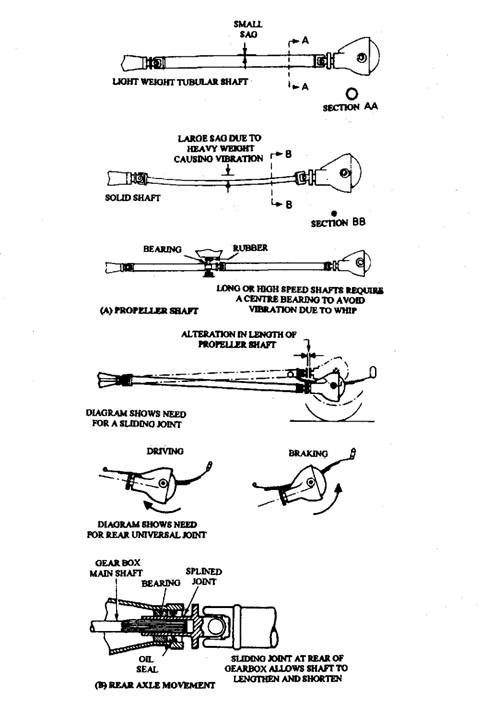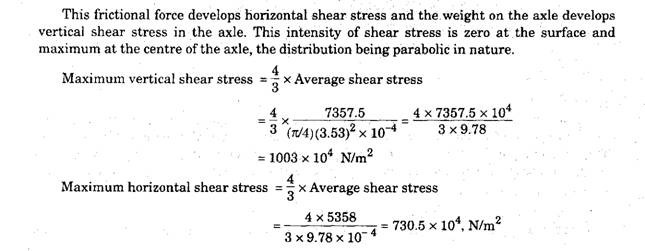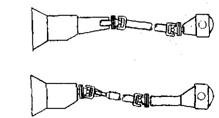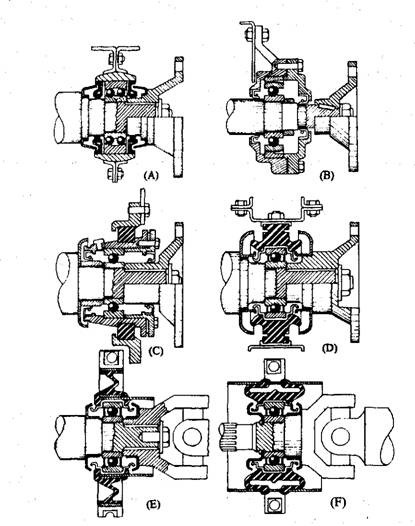Drive line, Differential and Road Wheel Drives
Propeller shaft connects gearbox to the final drive gears of the vehicle through universal joint and serves as drive shaft. A universal joint allows the drive to be transmitted through a variable angle. The drive system is an arrangement for transmitting the driving thrust from the road wheels to the vehicle body. The final drive is the transmission system between propeller shaft and differential. The differential mechanism is built into the centre portion of the final drive. This permits the wheels to rotate at different speeds without interfering with the propulsion of the vehicle while taking a turn. In case of rear wheel drive, the rear axle is “live”, which in addition to support the weight of the vehicle contains a gear and shaft mechanism to drive the road wheels. The chapter deals all these subsystems for a rear wheel drive system. Also it presents briefly front-wheel drive and four-wheel drive systems.
26.1.
Propeller Shaft and Drive Shaft
Propeller shaft, sometimes called a carden shaft, transmits power from the gearbox to the rear axle. Normally the shaft has a tubular section and is made in one- or two-piece construction. The two-piece arrangement is supported at the mid point by a rubber mounted bearing. Short drive shafts are incorporated for the transmission of power from the final drive assembly to the road wheels in both front and rear wheel drive layouts.
26.1.1.
Propeller Shafts
This shaft must be strong to resist the twisting action of the driving torque and it should be resilient to absorb the torsional shocks. It must resist the natural tendency to sag under its own weight because vibration occurs when the centre of gravity does not coincide with the axis of the shaft.
A tubular-section propeller shaft is normally used because it has (i) low weight, (ii) provides large resistance to misalignment, especially sag, (Hi) has good torsional strength, and (iv) provides low resistance (low inertia) to changes in angular speed, which arise when a hookes type coupling is used to drive the shaft. Since a propeller shaft often rotates at high speed, specifically during the use of the overdrive gear, it must be manufactured, and repaired, meeting design specifications and good balance limits.
Even after a perfect static alignment, shaft sags (i.e. forms a bow) at the centre due to its own weight. When this sagging becomes excessive, rotation of the shaft causes the bow to increase due to the centrifugal effect. This deformation, or whip of the shaft, sets up a vibration that becomes severe as it approaches the whirling speed. The critical speed at which this condition occurs depends on two vital dimensions i.e., the mean diameter of the tube and the length of the shaft.
Since propeller shafts of road vehicles are sufficiently long and operate in general at high speed, whirling may occur at certain critical speed. This produces bending stresses in the material that are higher than the shearing stresses caused by transmitted torque. While the critical speed increases with decrease in the mass of the shaft, the moment of inertia of the section increases. The tendency for the propeller shaft to whirl should be reduced and to do so, it should be made tubular and should be perfectly balanced.
Critical speed of the propeller shaft varies directly as the diameter of the tube and inversely as the square of the length. Therefore, diameters are selected as large as possible and lengths as short as possible to keep the critical speed frequency of the shaft above the driving speed range. Propeller shafts over 1.5 m length between universal joints cause unbalance problems. Shaft lengths are minimized by using long transmission extension housing and centre universal joint with two-piece propeller shafts. When used, the centre universal joint is supported by a centre support bearing which is insulated from the vehicle chassis. The propeller shaft tubing is usually rolled from flat sheet, straightened within 0.25 mm, run-out and balanced within 0.00018 kg-m. This keeps the centre mass very nearly on the longitudinal axis centre to minimize whirl. The critical speed is given by,

Propeller shafts are so designed that the calculated critical speed is about 60 percent higher than the engine speed at maximum power. Propeller shafts can also be designed for a given torque rating, which is the torque required to stress them to the elastic limit.

Many vehicles with rear- and four-wheel drive require a long propeller shaft to span between the gearbox and final drive. In these situations the drive line is normally divided and a bearing is fitted to support the shaft at the point of division (Fig. 26.1). This bearing is mounted in rubber to absorb any vibration that would otherwise be transmitted to the body.
Although axle movement is restricted to the rear shaft and universal joints are fitted to accommodate this movement, extra joints are needed on the front shaft to allow for the slight flexing of the vehicle body. It is practically impossible to maintain the correct drive angles of hooke-type couplings fitted to a two piece shaft layout, so one or more CV joints are used in many arrangements.
The composite propeller shaft shown in Fig. 26.2 is an alternative to the divided arrangement. The tubular shaft is made of epoxy resin, which is strengthened by using glass and carbon fibres, and bonded to a steel spigot for connection to the universal joints. The advantages of the composite shaft over a conventional two piece steel shaft arrangements are :
(i) Weight reduction by about 50 percent.
(ii) High internal shock absorption.
(Hi) Good noise, vibration, harshness (NVH) performance. (iv) Exceptional corrosion resistance.
Example 26.1. An automobile engine develops a maximum torque of 162 Nm. The low gear ratio of transmission is 2.75, while the back axle ratio is 4.25. The effective wheel radius is 0.325 m and the coefficient of friction between the tyre and the road surface is 0.6. If the permissible
shear stress is 32373 x 104 Pa, determine the maximum shaft diameter, assuming that the load is nearly torsional. What is the maximum load permissible on each wheel ?
Solution.
Overall gear ratio = 2.75 x 4.25

Fig. 26.1. Propeller shaft features. A. Propeller shafts. B. Rear axle movement.

Example 26.2. An engine develops 29.5 kWat 2000 rpm when the torque is maximum. The bottom gear ratio is 3:1 and the back axle reduction is 4.5:1. The load on each driving axle is 7357.5 N when the car is fully loaded. Diameter of road wheel over the tyres, is 0.71 m and the coefficient of adhesion between tyre and rod is 0.6. If the permissible stress in the material of the
shaft is not allowed to exceed 22072.5 x 104 Pa, find the diameter of the axle shaft.
Solution.


Both together produce maximum stress at the centre, which is too less in comparison to design stress. Again the intensity of shear stress due to torsion is highest at the surface and zero at the centre of the axle. Thus the shaft is quite safe in direct shear.
Diameter of the axle – 35.3 mm. Ans.
26.1.2.
Drive Shafts
These shafts are comparatively short in length and where space is a limitation, they are made solid to provide clearance for movement of the suspension, and otherwise the lightweight tubular section is often used. The short distance between the road wheel and the final drive housing, combined with a large road wheel movement due to suspension deflection, causes the maximum drive angle of the universal joints and large variation of length of the shaft. A CV joint at each end of the drive shaft meets the angle requirement and a plunge CV joint accommodates the length change. Rear-wheel drive vehicles having independent rear suspension need a drive shaft to connect the road wheel to the fixed final drive assembly. On these vehicles normally a plunge-type CV joint is incorporated at each end of the drive shaft.
26.1.3.
Propeller Shaft Vibration
Small cars and short vans and trucks incorporate a single propeller shaft with a slip-joint at the front end without having any undesired vibration. Vehicles with longer wheelbase requires longer propeller shaft, which has a tendency to sag and to whirl under certain operating conditions (Fig. 26.3). As a result resonant vibrations are set up in the body of the vehicle, so that the body vibrates as the shaft whirls.
The main factors responsible for the resonant frequency of the propeller shaft causing the vibration may be grouped as follows :
(i) Factors related to the propeller-shaft are (a) the diameter and length of the shaft,
(6) the balancing of the assembled shaft and joints, and (c) the bending resistance of the shaft.

Fig. 26.3. Simple one-piece propeller shaft using one slip-joint and two universal joints.
(ii) Factors related to the vehicle-body are
(a) the type and shape of body structures, reinforcement
box-sections, etc., (6) the location of components within the body structure,
and
(c) the qualities of drive-line vibration-clamping provided by engine and transmission mounts, spring bushes panel insulation, etc.
A rotating shaft whirls if the centre of gravity of the mass of the shaft is eccentric due to which centrifugal force tends to bow the shaft so that it orbits about the shaft’s longitudinal axis. The eccentric deflection of the shaft increases with rise of the speed as a result the centrifugal force also increases. The effect is therefore cumulative and progressive until the whirling becomes critical causing violent vibration.
The factor responsible for the shifting of the centre of gravity of a horizontally supported circular shaft between bearings to one side of the central axis are as follows.
(a) The sagging of the shaft between centers.
(b) Non-uniform wall thickness around the circumstances of a tubular seamless drawn propeller shaft.
(c) The amount of weld metal may not be equivalent to the mass on the opposite side of a tubular shaft, rolled up from flat sheet.
(d) The eccentricity of the shaft to the axis of rotation caused if the tubular shaft is forced on to universal-joint stub-shaft recesses, which have been turned between loose centres.
(e) If the joint yokes and trunnion arms are assembled very slightly to one side, when universal joints are fitted to the ends of the shaft, which are then supported on bearings.
(/) If the clearance between the male and female splines allows the shaft to be moved over to a limited extent, when a slip-joint coupling is used at one end of the shaft.
The critical whirling speed of a shaft is inversely proportional to the square of the length of the shaft. For example, if a shaft with a critical whirling speed of6000 rpm is doubled in length, the critical whirling speed of the new shaft reduces to 1500 rpm, the quarter of this value. On the other hand, by halving the length of the shaft, the critical speed increases to fourfold, i.e. 24000 rpm. Thus, halving the length puts the critical speed considerably above the maximum propeller shaft speed for a vehicle.
Generally the rigidity of the propeller shaft is increased by extending either the rear end of the gearbox main shaft and housing (Fig. 26.4A) or the final-drive pinion shaft and housing (Fig. 26.4B). The former approach is common for medium sized cars, and the later has been used with some success on bigger cars having rear coil spring suspension with trailing arms and the tie rod stabilizers. A slip-joint is normally installed at the gearbox end of the propeller shaft, which allows the propeller shaft to automatically adjust its length in accordance with suspension deflection changes.
Another method of solving the vibration problem is by increasing the diameter of the shaft, but this increases its strength beyond its torque-carrying requirements. Also this increases its inertia, which opposes the vehicle’s acceleration and deceleration. A solution adopted frequently is the use of divided propeller shafts supported by intermediate or centre bearings. This approach has also been employed in the past on large cars to lower the transmission (A) drive from the front-mounted gearbox to the rear axle. As a result the floorboard tunnel height is reduced, and the disadvantages of a thicker shaft are avoided. “When this arrangement is used on commercial vehicles, large offsets ® between gearbox centre lines and the final-drive pinion , centre line can be provided in two or three stages.
rig.
26.1.4.
Divided Propeller Shafts and their Support
Two-piece drive-lines, with two shafts and an intermediate support bearing (Fig, 26.5) are generally employed on trucks having wheelbases from 3.4 to 4.8 m. The two-piece propeller shaft uses three universal joints. The primary propeller shaft is of the fixed-joints-and-tube-assembly type, and the secondary propeller shaft incorporates a slip-joint at the support-bearing end to take care of any extension due to suspension movement. Generally the primary shaft is in line with the gearbox main-shaft axis, but the secondary shaft is slightly inclined to intersect the pinion shaft of the rear-axle final-drive. However in case of high-chassis-mounted vehicles, both shafts are fitted inclined to reduce the effective shaft inclination angle. When the primary shaft is in line with the output shaft of the gearbox, rubber-type universal couplings are sometimes utilized to damp out transmitted torsional vibration more effectively than conventional steel joints.
For vehicles with wheelbases more than 4.8 m, a three-piece drive-line with two intermediate support bearings may be more suitable (Fig. 26.6). Four universal-joints are employed and the intermediate shaft lies parallel to the output shaft of the gearbox. Only the rear propeller shaft again uses a slip-joint to accommodate change in shaft length.
26.1.5.
Propeller Shaft Intermediate Support Bearings
Intermediate bearing-and-mount assemblies are incorporated to position and support the divided propeller shafts. These assemblies are either of (i) self-aligning bearing supports type of («) flexible-mounted bearing supports type. Self-aligning intermediate-bearing supports are mostly used on heavy-duty trucks. One type of this bearing support is a double-row ball-bearing with a deep-grooved inner race and an internally semicircular outer race (Fig. 26.7A). This arrangement compensates any shaft deflection through the inner race and balls, which tilt about the fixed outer-race spherical seat.
Another method is the use of a single-row deep-grooved ball-bearing with a spherical profile on the periphery of the outer races. The ball race is then encased in a steel support ring whose internal profile matches the outside of the bearing (Fig. 26.7B). The relative movement of the bearing and the ring can absorb any misalignment. Since both the above arrangements require periodical lubrication, oil-seals are used to retain the grease and also to keep dirt out of the bearing tracks.

Fig. 26.4 One piece drive-line. A. with extended gearbox housing.
B. with extended differential housing-

Fig. 26.5. Two-piece drive-line with single intermediate support bearings.

Fig. 26.6. Three-piece drive-line with two intermediate support bearing.

Fig. 26.7, Divided’propeller-shaft support-bearing assemblies.
A. Commercial-vehicle double-row self-aligning bearing support.
B. Commercial-vehicle single-row self-aligning outer bearing race.
C. Heavy-duty rubber-block bearing mount.
D. Medium-and heavy-duty flexible bearing mount.
E. Car and van V-sectioned rubber bearing mount.
F. Car and van double fold rubber bearing mount.
Flexible-mounted intermediate bearing supports are used for both light and heavy vehicles. These types employ a single-row deep-grooved ball-bearing, which fits directly over one of the divided shafts, and a member, which surrounds this bearing, is enclosed in a steel frame. This assembly is then bolted to the chassis or body shell to support the intermediate shafts. The rubber mounting acts as a flexible support for the bearing, which accommodates a slight tilt of the shaft. The flexible rubber also acts as a vibration damper and isolates any propeller shaft vibrations from the body members.
Figure 26.7C illustrates the use of a solid rubber ring block, which fits over a bearing hub for extra-heavy duty applications. The inner bearing race is located by the universal-joint flange and that the outer bearing race is positioned by a shimmed sleeve. This assembly requires regular lubrication. Presently most light- and heavy-duty intermediate-bearing assemblies use pregreased and sealed-for-life deep-groove bearings. Dust-baffles mounted on the shaft protect the bearing against grit and wet weather. The rubber element is bonded both to the external steel casing and to the outer bearing-race steel pressing. A bearing arrangement, illustrated in Fig. 26.7D, is used for commercial vehicles. A slot is made on each side of the rubber moulding to improve flexibility.
A bearing layout suitable for cars and vans is shown in Fig. 26.7E. The rubber element uses a V-shaped section, which permits the element to fold and move about its mean position more readily. Also this improves the vibration-damping properties of the rubber assembly. Figure 26.6F represents an alternative layout for light vehicles. In this assembly the moulded rubber section forms double link-arms, which provide greater rigidity for the bearing and excellent damping properties, without loosing its easily tilting characteristics.
